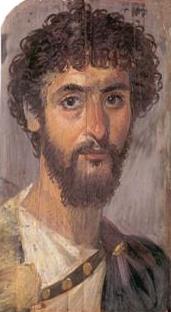Bearded Soldier, c. 165 CE
Bearded Soldier
Bearded soldier, probably from Philadelphia (El-Rabaiyat) in the Faiyum
c. 165 CE. Encaustic on wood. H. 40 cm, 15 ¼ in.
Myers Museum of Egyptian and Classical Art, Eton College, Windsor.
In Roman Egypt, it was customary to attach a painted portrait of the deceased person over the head of the body wrapped up in bandages. These paintings were created by artist working in the Greek artistic style, and the encaustic (painting in wax) technique was not known in ancient Egypt. They represent Egypt’s new art, which sometimes drew on an earlier pharaonic tradition but was mostly inspired by the arts which originated outside the country. The paintings are known as Faiyum portraits, after the area where many were initially found, but their distribution is much wider. There is little doubt that they were real portraits. Most of them date to the first two centuries of our era and some seem to be even later. Some ancient Egyptian funerary customs survived longer than the art forms in which they were originally expressed. In pharaonic Egypt, attempts were always made to preserve the person’s face so that after their death the ba (personality) was able to recognize the body to which it belonged, and the Faiyum portraits paralleled this ancient Egyptian tradition. That the man in the painting illustrated here was a soldier is indicated by the swordbelt hung across his shoulder.
Malek, Jaromir, Egypt; 4000 years of Art. London- Phaidon Press, 2003.




